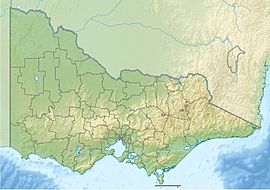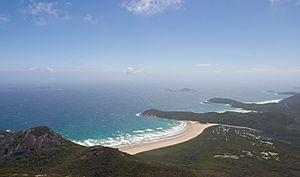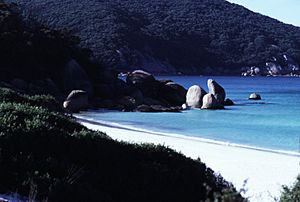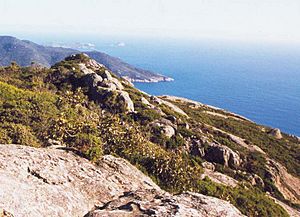Wilsons Promontory National Park facts for kids
Quick facts for kids Wilsons Promontory National ParkVictoria |
|
|---|---|
|
IUCN Category II (National Park)
|
|
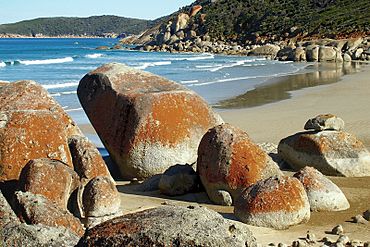
Colourful rocks within the national park.
|
|
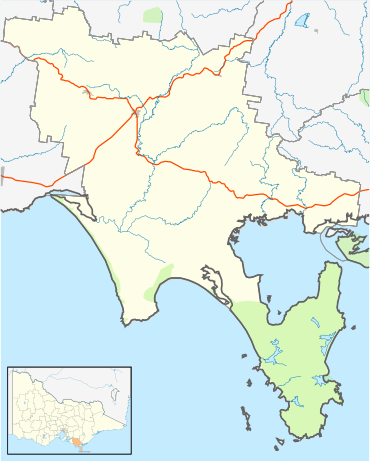
Map of South Gippsland with the national park shown in green on lower right
|
|
| Nearest town or city | Yanakie |
| Established | July 1898 |
| Area | 505 km2 (195.0 sq mi) |
| Managing authorities | Parks Victoria |
| Website | Wilsons Promontory National Park |
| See also | Protected areas of Victoria |
Wilsons Promontory National Park, often called Wilsons Prom or The Prom, is a beautiful national park in Victoria, Australia. It is about 157 kilometres (98 miles) southeast of Melbourne. This park is the southernmost national park on mainland Australia.
The park covers 50,500 hectares (124,790 acres). It is famous for its amazing rainforests, lovely beaches, and lots of different animals. The park is on the southern part of Wilsons Promontory, which is a peninsula. This peninsula includes South Point, the most southern spot on the Australian mainland. There is also a lighthouse at the south-east corner of the peninsula. It has been working since 1859 and is the southernmost lighthouse on mainland Australia.
Wilsons Prom is very popular with people who love to hike and camp. There are places to stay and camping areas near the Tidal River.
Contents
History of Wilsons Prom
People have lived in the Wilsons Promontory area for a very long time. Indigenous Australians were here at least 6,500 years ago. We know this from old records found by archaeologists.
The first Europeans to see Wilsons Promontory were likely George Bass and Matthew Flinders in 1798.
In the 1800s, a lot of seal hunting happened at Sealer's Cove. Because of this, seals are no longer found there today.
Groups like the Field Naturalists Club of Victoria worked hard to protect the area. In 1898, the Government of Victoria made it a temporary National Park. It became a permanent park in 1908.
During World War II, Wilsons Promontory was used as a training area for commandos. There is a special memorial at Tidal River for commandos who died in the war.
In April 2005, a large part of the park was burned by a bushfire. This fire started from a controlled burn that got out of control. It happened because the weather became warmer and windier than expected. About 600 people had to leave the park for safety.
In February 2009, during the Black Saturday Fires, lightning strikes caused more fires. Up to 50% of the national park was badly damaged by these major fires.
Camping at Tidal River
Tidal River is the main place to stay and camp in Wilsons Promontory National Park. The Tidal River Campground has 484 sites for tents and caravans. Twenty of these sites have power. They are all close to the beach and the river. There are also 11 remote camping sites deeper inside the park. You have to walk to reach these.
The Tidal River camping ground is located in sand dunes behind Norman Bay. This is on the western side of the peninsula. The only road for visitors goes from Yanakie to Tidal River. This drive is about 32 kilometres (20 miles) long.
When the park is full, over 2,000 people can be staying at Tidal River. There is a visitor centre that is open every day. You can also find a general store that sells basic groceries and emergency items. It also offers fish and chips and other takeaway food.
The outdoor cinema started in the late 1940s. It is a favourite for campers in summer. People sometimes line up for over an hour to get tickets and save a good seat.
During the summer holidays, from Christmas to late January, a special system is used to give out camping spots. You have to enter a ballot (like a lottery) to get a site. No matter when you visit, all places to stay must be booked in advance.
Amazing Wildlife
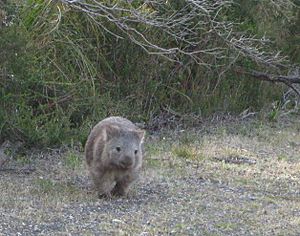
Wilsons Promontory National Park is home to many different kinds of animals. You can see kangaroos, wombats, echidnas, and emus. There are also many small marsupials and lots of bird species. The most common birds are the rosellas.
The animals near Tidal River are used to people. Many of them might come close to you. Some might even try to enter your tent! However, it is against the rules to feed the wildlife. If you are caught feeding them, Parks Victoria staff will give you a fine.
Away from the camping area, the animals are shyer. They might be harder to spot. You can often find possums at night using a torch. Kangaroos and emus are often seen in large groups along the road into the park. Swamp wallabies are often seen on many of the walking trails. You can also spot many different bird species. The northern part of the park also has many snakes.
In the waters around the park, you might see Southern right whales. Their numbers are slowly growing. They use this area as a nursery, just like they used to. Humpback whales also pass through the area. You can more regularly see Killer whales, dolphins, seals, sea lions, and penguins.
Hiking Adventures
Wilsons Prom has many different hiking trails. There are trails for all skill levels. You can find short walks that take only a few hours. These often use ramps to access beaches. There are also longer walks that take 2 or 3 hours.
For those who want a bigger adventure, there are overnight hiking options. You can combine these into longer trips that last two days or more. The northern part of the park has multi-day hikes. These require good navigation skills. You need a permit for all overnight hiking trips.
Part of the peninsula is a warm temperate rainforest. These areas usually have boardwalks and bridges to walk on. Here, you might see different bird species and swamp wallabies. The park also has some mountainous areas.
Climbing Mount Oberon
Mount Oberon is a popular spot in Wilsons Promontory National Park. Hikers can drive part of the way up to the Telegraph Saddle car park. From there, you continue on foot. You follow an uphill track to the summit of Mount Oberon.
A short set of steps near the top leads to amazing views. You can see Tidal River, the coast, and the islands offshore. It can be windy, cool, and cloudy at the summit, even in summer.
Another great walk is up Mount Bishop. It also offers wide views of the Prom. The coastline is rugged with many coves and beaches. These are mixed with granite headlands, rock formations, and cliffs. The beaches range from wide sandy areas to steep coves and rock pools. The northern part of the park has a lot of the Yanakie Isthmus, with sandy healthlands.
Images for kids
-
A Common wombat at Wilsons Promontory National Park
See also
 In Spanish: Parque nacional Promontorio Wilsons para niños
In Spanish: Parque nacional Promontorio Wilsons para niños


